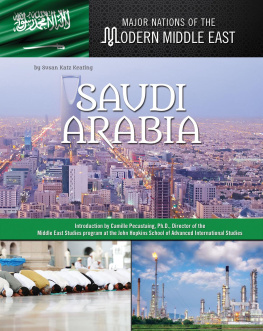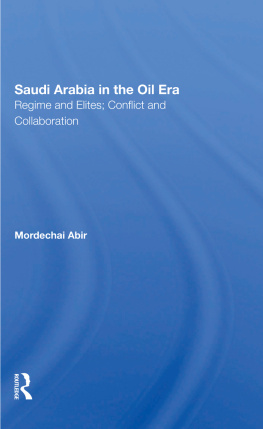Wahhabism
___ and the Rise of the ___
HOUSE OF SAUD
Wahhabism
___ and the Rise of the ___
HOUSE OF SAUD
TARIK K. FIRRO
Copyright Tarik Firro, 2018.
Published in the Sussex Academic e-Library, 2018.
SUSSEX ACADEMIC PRESS
PO Box 139, Eastbourne BN24 9BP, UK
Distributed worldwide by
Independent Publishers Group (IPG)
814 N. Franklin Street
Chicago, IL 60610, USA
ISBN 9781845199340 (Cloth)
ISBN 9781782845782 (EPub)
ISBN 9781782845799 (Kindle)
ISBN 9781782845522 (Pdf)
All rights reserved. Except for the quotation of short passages for the purposes of criticism and review, no part of this publication may be reproduced, stored in a retrieval system, or transmitted, in any form or by any means, electronic, mechanical, photocopying, recording or otherwise, without the prior permission of the publisher.
British Library Cataloguing in Publication Data
A CIP catalogue record for this book is available from the British Library.
This e-book text has been prepared for electronic viewing. Some features, including tables and figures, might not display as in the print version, due to electronic conversion limitations and/or copyright strictures.
Contents
Preface
During the preparation of this study I consulted a number of friends who are familiar with Wahhabism and was encouraged to elaborate further the main topics dealt with in my doctoral thesis, Al al-Shaykh in the Second Saudi State, 18241891 (2003). This book expands the thesis discussion to include topics that would accommodate my presentation to the requirement of readers who look for an understanding of the socioeconomic, political, and religious conditions behind the emergence of the WahhabiSaudi movement during the eighteenth and nineteenth centuries, before the establishment of the modern Saudi kingdom. To do so, I provide an outline of the importance of the tribal features of Najd and elsewhere in Arabia, and describe and analyze the interrelation between religion and politics that characterized the SaudiWahhabi alliance from the eighteenth century onward.
The present book follows the main historical events that occurred in the eighteenth and nineteenth centuries, which constitute, in my view, the main turning points in the history of the SaudiWahhabi movement and still affect the political and religious life of modern Saudi Arabia. In order to explain these turning points, chapter discussions go back to socioeconomic and intellectual developments in Najd before the eighteenth century that formed the background of the movements emergence and its ability to survive. The study attempts to reassess the connection between Wahhabism and Hanbaliyya (Hanbalism), focusing on the salafi principles articulated in the writings of the pre-Wahhabi scholars and their influence on the preaching of Ibn Abd al-Wahhab and other Wahhabi scholars.
I hope that this book will provide new insights into the socio- political, cultural, and religious background of the modern Saudi state, and illuminate a wider canvas than a mere political history of this state.
This study could not have been completed without the help of a number of friends and institutions, and I am grateful to all of them. I appreciate the assistance I received from the Middle East Department, Ben-Gurion University of the Negev, where I completed my doctoral thesis. It is a special pleasure to acknowledge my gratitude to Dr Nimrod Hurvitz and Prof. Dror Zeevi, who kindled my interest in the subject of Wahhabism, inspired me, and stimulated my mind with their helpful comments. I was especially fortunate during the final stages of my book to have had the help of Dr Michael Appel, ex-chairman of the Department of Middle Eastern History at Haifa University, where I spent one year of postdoctoral research. Acknowledgement is due to the directors and staff of various institutions and libraries in England. I am especially grateful to Prof. Eugene Rogan, Director of the Middle East Centre of St Antonys College, Oxford, where I spent four months of research on this study. His suggestions and our conversations influenced and inspired my research.
Last but not least, I would like to acknowledge the support of my wife Mayada, who helped and encouraged me to bring this study to fruition. In gratitude for the patience and understanding she has shown, I dedicate this book to her and to our children, Umri and Yusuf.
Note on Transliteration
English transliteration of Arabic terms follows the International Journal of Middle East Studies with slight differences. Terms in Arabic are italicized without a capital letter, such as hadith, sharia, sunna. Names have been given according to their Arabic form in order to ensure uniformity, with only a few exceptions (e.g. Riyadh, Saud, Saudis, Karbala).
Introduction
The emergence of the Wahhabi movement in the eighteenth century in Najd has occupied and still occupies researchers of modern Islam. The present research will follow the vicissitudes of this movement, investigating the religious, political, cultural, and social factors that enabled its religious and political leaders to keep it alive, despite internal and external challenges. No doubt, Muhammad Ibn Abd al-Wahhab (170391), the founder of the doctrine, and his successors (Al al-Shaykh) played a major role in introducing religious reforms into Najd and other areas of Arabia. But these reforms could not be understood without examining the sociopolitical framework that enabled the first Wahhabis to propagate their religious convictions. The focal themes to be investigated in this study are the socio-economic, cultural, religious, and political conditions that affected the history of the Wahhabi movement before the twentieth century.
Although the study focuses on Wahhabism of the nineteenth century, it follows the development of the doctrine since its foundation in the eighteenth century, attempting to employ an integrative method based on an interdisciplinary approach. Of course, such attempts must naturally confront the fact that our study cannot cover all aspects, and that some of them have to be set aside for other studies.
To reach a relatively comprehensive study, several sources have been taken together. Before dealing with the primary sources, we refer to the general sources consulted in this study. So far, only two MA dissertations have dealt directly with the political development of Arabia during the Second Saudi State. The first was written by Abd al-Fattah Abu Aliya at the University of Cairo in 1969, al-Dawla al-Saudiyya al-Thaniyya, 12561309/18411891 (The Second Saudi State, 18401891), and was published in Riyadh in 1985. This work is no more than a historical record of military and political activities of Faysal Ibn Turki (17881865) within Najd and Arabia. The second dissertation was written by Avital Ashkenazi Holdenburg, Faysal Ibn Turki and the Second Saudi State. Although she refers to the Wahhabi judicial system, Holdenburg follows Abu Aliyas political and military survey. In addition to these two works, two books were consulted: the first was written by Richard Bayly Winder, Saudi Arabia in the Nineteenth Century, which deals with the political development of the Second Saudi State and its relations with the Western powers and the Ottoman Empire, and the second book was written by Alexei M. Vassiliev, The History of Saudi Arabia, which follows the historical development of Wahhabism since the eighteenth century until the Kuwait War in 19901.













